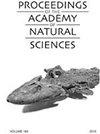A Late Pleistocene capybara (Rodentia, Caviidae, Hydrochoerinae) from near Houston, Texas, USA, with a brief review of North American fossil capybaras
IF 0.5
4区 环境科学与生态学
Q4 BIODIVERSITY CONSERVATION
Proceedings of the Academy of Natural Sciences of Philadelphia
Pub Date : 2020-03-17
DOI:10.1635/053.167.0105
引用次数: 1
Abstract
ABSTRACT. A capybara jaw (Rodentia, Caviidae, Hydrochoerinae) and an isolated lower tooth fragment were recovered from dredge spoils on Pelican Island in Galveston Bay, Gulf Coast of Texas. The attached matrix on the jaw and most of the dredged material is clay, indicative of the latest Pleistocene Beaumont Formation which underlies the Holocene deposits. In the latest Pleistocene (Rancholabrean) of the United States, capybaras are known from along the Gulf and Atlantic coasts in Texas, Florida, Georgia, South Carolina, and Virginia.These Rancholabrean capybaras have been assigned to three different taxa: Neochoerus pinckneyi Hay, 1923 for the largest size specimens, Hydrochoerus holmesi Simpson, 1928 for the somewhat smaller specimens, or Neochoerus aesopi Leidy, 1853, a name that had been considered invalid because it was not adequately diagnosed, if there is only one late Pleistocene species of North American capybara. The p4 in the new Texas mandible is much smaller than the genotype of N. pinckneyi from the Aransas River in South Texas and similar in size to H. holmesi from the Pleistocene of Florida and Recent H. hydrochaeris. However cheek tooth size and occlusal pattern in Recent capybaras varies significantly with age. Hydrochoerus holmesi cannot be distinguished from N. pinckneyi. None of the late Pleistocene capybaras of South Carolina, including the type and referred specimens of N. aesopi, have any characteristics to differentiate them from H. holmesi or N. pinckneyi. We therefore assign all the Texas and South Carolina specimens to N. aesopi.美国得克萨斯州休斯顿附近的一种晚更新世水豚(啮齿目、鱼子科、水豚科),对北美水豚化石的简要回顾
摘要在德克萨斯州墨西哥湾沿岸加尔维斯顿湾鹈鹕岛的疏浚残骸中,发现了一个水豚颚(啮齿目,洞穴科,水豚科)和一个孤立的下牙碎片。颚部附着的基质和大部分疏浚物为粘土,表明其为全新世沉积物下的最新更新世博蒙特组。在美国的最新更新世(Rancholabrean),水豚在德克萨斯州、佛罗里达州、佐治亚州、南卡罗来纳州和弗吉尼亚州的墨西哥湾和大西洋沿岸被人们所知。这些Rancholabrean水豚被划分为三个不同的分类群:最大的标本Neochoerus pinckneyi Hay, 1923年,稍微小一点的标本Hydrochoerus holmesi Simpson,或者Neochoerus aesopi Leidy, 1853年,如果只有一个晚更新世的北美水豚物种,这个名字被认为是不成立的,因为它没有得到充分的诊断。新发现的德克萨斯州下颌骨中的p4比来自南德克萨斯州Aransas河的N. pinckneyi的基因型小得多,与来自佛罗里达州更新世的H. holmesi和最近的H. hydrochaeris的大小相似。然而,现代水豚的颊齿大小和咬合模式随着年龄的变化而变化。holmeshydrochoerus不能与平克尼水蚤区分开。南卡罗莱纳的晚更新世水豚,包括N. aesopi的类型和参考标本,都没有任何特征可以将它们与H. holmesi或N. pinckneyi区分开来。因此,我们将所有的德克萨斯和南卡罗莱纳标本归为伊索伊蚤。
本文章由计算机程序翻译,如有差异,请以英文原文为准。
求助全文
约1分钟内获得全文
求助全文
来源期刊

Proceedings of the Academy of Natural Sciences of Philadelphia
生物多样性保护-生物多样性保护
自引率
0.00%
发文量
4
期刊介绍:
The Proceedings (ISSN 0097-3157) has been published continuously since 1841. Many volumes are still available in their original printings. Early volumes are unbound, constituting two or three issues per year. Quantities of some volumes may be limited. Early volumes may have slightly soiled cover sheets, but the text blocks are perfect.
 求助内容:
求助内容: 应助结果提醒方式:
应助结果提醒方式:


